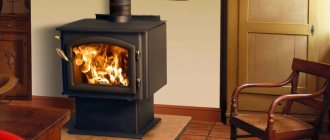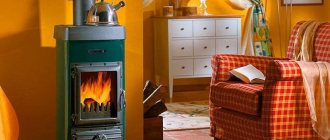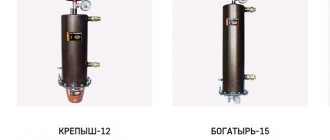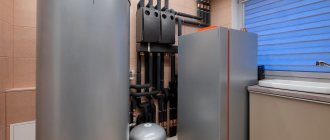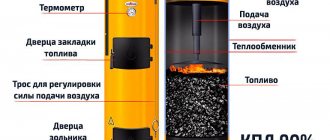Regardless of the effectiveness of the smoke removal and ventilation system in the boiler room, when solid fuel is added, soot escapes from the chamber and settles on the ceiling and walls. Outdoor wood boilers do not require installation in a special room. They can be installed in a place remote from residential premises, on the edge of the local area.
Types of outdoor wood boilers
Outdoor heating units are:
- solid fuel standard design;
- top combustion with a chamber in the form of a cylinder;
- pyrolysis with high-temperature splitting of firewood into highly flammable gases;
- long burning with a shaft to increase the volume of fuel storage;
- equipped with a screw feed of granulated or pressed raw materials.
Where to buy a coal boiler for heating a private house
In Moscow
- Comfort-Eco, Dmitrovskoe shosse, 100, building 2, tel. +7 (495) 921–37–61.
- My Boiler, Volokolamskoe highway, 116 building 2, tel. +7 (495) 221–56–79.
In St. Petersburg
- TechnoDom, Stachek Ave. 57, Komsomolskaya Square, tel. +7 (812) 671–00–88.
- Kit-Teplo, st. Litovskaya 8, +7 (812) 295–00–05, +7 (812) 248–18–88.
To summarize, it is worth saying that coal boilers are the “golden mean” between ease of use and fuel costs, so if the house is not connected to the gas main, then its installation is completely justified. Even better is the automatic version: it will help you survive even the harsh winter in comfort.
InstructionsLong burning boilersPyrolysis boiler unitsSolid fuel boilersCoal boilers
Boiler design
Devices for heating rooms convert combustion energy into heat, while volatile substances are removed through the chimney. Structurally, the boiler is a wood-burning stove made of steel sheets.
To increase efficiency, the combustion chamber is covered with a double layer of metal plates. The sealed mediastinum, formed by the outer and inner iron casing, forms a water jacket, which is filled with coolant.
The boiler has fittings for connecting the supply and return pipelines.
The design consists of the following parts:
- housings made of steel sheets or cast iron elements;
- combustion chamber;
- grate;
- ash collection compartments;
- smoke exhaust duct;
- mediastinum filled with coolant (water jacket);
- an insulating layer to protect against atmospheric influences and prevent energy losses;
- devices for pumping air into the combustion chamber;
- circulation pump;
- control module.
Principle of operation
The coolant that fills the water jacket is heated by the energy of the burned fuel. Circulation pumps supply hot working fluid through an insulated underground pipeline into the house, where it is distributed to radiators. The cooled water returns to the boiler mediastinum for reheating.
As the fuel burns out, additional loading is carried out and the ash pan is cleaned.
Advantages and disadvantages
Outdoor units have a number of advantages:
- Reliable electronic module that controls the device. It supplies dosed air to the combustion chamber, monitors the temperature in the firebox and water circuit, and controls the intensity of the circulation pump.
- The large front door makes it easy to load firewood and clean the internal elements from soot and carbon deposits.
- The combustion chamber has the shape of a cylinder. The energy from the flame is distributed evenly in it, and intense gas and heat exchange occurs. This promotes fast and efficient heating of the water circuit. In the cylindrical chamber there are no areas of increased temperature exposure, as a result of which the walls of the boiler can deform and burn out.
- The outdoor heating unit is equipped with a lighting lantern for ease of maintenance at night.
- The chimney and boiler are reliably protected from atmospheric influences, thermal insulation is made of special materials.
The undeniable advantage of an outdoor boiler is the ability to effectively heat several separate rooms at the same time.
The disadvantages of such units include the need for:
- organizing a site for storing firewood;
- periodically filling the combustion chamber with fuel;
- scheduled cleaning of soot and soot.
Can I do it myself at home?
Outdoor boilers are massive and bulky devices. Their weight can reach a ton, and the volume of coolant contained by the water circuit is 400-700 liters. These units are made of special materials that can withstand prolonged high-temperature exposure, with minimal deformation.
High-density basalt fillers are used for thermal insulation of outdoor wood-burning boilers. In a home workshop, it is problematic to produce a device of such mass and dimensions. But despite this, with the proper level of mechanization and possession of the necessary skills, you can make a small outdoor boiler yourself.
Many manufacturers provide a lifetime warranty on their devices. This indicates the highest quality of materials used in the construction and the professional level of the workers.
Which company should you choose?
Solid fuel boilers equipped with a water circuit are produced by various manufacturers, among which stand out:
- Teplodar is a Russian company with patented technologies that supplies high-quality heating equipment throughout the world.
- Zota is a Krasnoyarsk brand that supplies inexpensive components and boilers of low cost and high build quality.
- Stropuva is a young Lithuanian company that has patented a candle-type long-term combustion technology. It produces models taking into account the climatic characteristics of countries and regions.
How are they different from other equipment?
In terms of the method of obtaining energy for heating premises, outdoor boilers are similar to traditional ones. Their indisputable advantage is that there is no need to specially equip the room for installing the unit. This factor eliminates the risk of fire or other threats to people living in the house.
The absence of a boiler room will eliminate a number of measures related to ensuring safety, and in the case of installing a unit on natural gas, it will eliminate the design and expensive installation of pipes.
Prices: summary table
Price rating of popular models of coal-fired boilers:
| Coal boiler model | Cost, rub. |
| ZOTA "Master" 20 | 34 000 |
| Protherm “Beaver” 20 DLO | 79 000 |
| Bosch "Solid" 2000 B SFU 12 | 80 000 |
| Stropuva S15U | 81 500–99 778 |
| Buderus "Logano" S181-15 E | 252 000–258 840 |
| LIEPSNELE L20U | 110 000 |
| Galmet "CARBO" 21 | 113 890–116 759 |
| ZOTA "Carbon" 20 | 47 900–53 290 |
| Teplodar "Kupper" OVK 10 | 23 050–25 680 |
| Thermocraft "Uragan" Prof 22 | 28 640–34 641 |
Poll: For what reason did you prefer a coal boiler?
Rating of the best outdoor wood-burning boilers for heating
The production of heating devices is carried out by manufacturers of various levels of equipment - from high-tech automated workshops to semi-handicraft firms. It is necessary to buy a home heating device from companies that have been on the market for a long time and have proven themselves well.
“Trayan TPG-15” (15 kW)
Single-circuit unit designed for use in forced and gravity heating systems. Capable of providing full heating of a house with an area of 100-130 m².
Kentatsu Furst Elegant-03
Non-volatile wood boiler from a Japanese brand. Cooled grates and a heat exchanger made of anti-corrosion cast iron are the key to a long service life. Operating time on one load is up to 4 hours.
“Teplov Universal TA-40” (40 kW)
Long-burning solid fuel unit for use in heating systems of industrial and residential facilities with a total area of up to 400 m². On the basic model, which does not require an electrical connection, an automatic control unit is installed if necessary. The device is unpretentious to fuel; it runs on wood, coal, and briquetted waste.
Zota Forta 12
The model is capable of heating an area of 100-120 m². When equipped with a bunker installation and a feeding auger, it can operate on granular fuel in automatic mode for several days.
Stropuva S30 (30 kW)
This powerful, non-volatile unit can easily handle heating a large home or commercial facility up to 300 m². The combustion chamber can be filled with any type of solid or granular fuel. The duration of work on one bookmark is from 1 day (with wood) to 2 (with pellets).
Wirbel Toby B Compact 12
A compact boiler from an Austrian brand that does not require an electrical connection. Single-circuit steel unit with a calculated heating area of 130-150 m². Production is licensed in Russia.
“Zota Topol-16VK” (16 kW)
The model with tubular water-filled grates has an increased level of heat transfer. The boiler is designed to heat rooms up to 160 m². Can operate on various types of solid fuel. The specially shaped chimney pipe eliminates blockages and burning of the walls.
Stropuva Mini S8 (8 kW)
A compact unit for efficient heating of small objects with an area of up to 80 m², has an environmental certificate. You can use coal, firewood, pellets or wood waste as fuel. The minimum burning time on one tab is a day. A large ash pan can be cleaned only 2-3 times a month. The vertical door makes loading fuel easy. Heating a dacha with a TT boiler would be the best option.
SAS UWT 14 (14 kW)
Steel solid fuel automated boiler, insulated with basalt wool, for use in closed and open heating circuits. A hot water supply boiler can be connected to the device. Designed for use as coal fuel. Heated area – 100-120 m².
Stropuva S40 (40 kW)
Powerful and reliable energy-independent long-burning boiler. Suitable for heating one or several closely spaced rooms with a total area of 400 m². The device provides equally high efficiency when operating on any type of solid fuel.
Bunker automatic boilers
Automatic coal boilers differ from previous versions in that all working processes are fully or partially (if we are talking about semi-automatic models) controlled by a programmable microprocessor controller connected to sensors and thermostats.
Long-term combustion is supported by forced air fans (superchargers) and a traction system for removing combustion products.
Model Zota Stakhanov 20. Coal is supplied by an automatic mechanism from a hopper connected to the boiler; supply volumes are regulated by the automatics of the boiler unit.
To ensure uninterrupted refueling, a loading hopper is provided - a metal box with a screw conveyor installed below.
The capacity of the built-in fuel tank in a bunker coal boiler is enough for an average of 2–7 days, and if the fuel is supplied from a separate mechanized storage facility, then depending on the area of its capacity it can last for 3–4 weeks or even for the entire heating season.
Criterias of choice
When purchasing, you need to pay attention to the following factors:
- Availability of fuel on which the boiler operates.
- You should not purchase a unit with maximum power or more than necessary. A device operating in nominal mode uses fuel much more efficiently.
- The parameters of the boiler are closely related to the dimensions of the room where it will be installed. Insufficient air volume in the boiler room or weak air pressure has a significant impact on the performance of devices with forced injection.
- The efficiency of the device varies when operating on different types of fuel. When choosing a boiler, you need to pay attention to the efficiency of its operation on the fuel that will be used most often.
- Units with a cast iron heat exchanger are more reliable than steel ones.
- The weight and dimensions of the equipment affect the requirements for the boiler room. It is necessary to discuss in advance with specialists how the unit will be delivered to the installation site, whether the doorway is wide enough to accommodate it, and whether the base on which the device will stand is strong enough.
- Door height for loading fuel and cleaning the ash pan. It should be convenient to maintain the installation and fill it with firewood.
- Boiler cost. The price is determined based on the technical characteristics, and also depends on the reputation of the company and the time during which the equipment of this brand has been produced.
Properly organized heat supply significantly affects indoor comfort. Rational use of resources for high-quality heating of housing, industrial or commercial facilities largely depends on the boiler unit. For this reason, you need to approach the choice of heating installation responsibly.
How to properly fire a coal boiler
Before putting the boiler into operation, it is necessary to configure its operation:
- test the heating system for strength by increasing the pressure × 1.25;
- check the draft by holding a strip of paper to the air supply damper;
- turn on the heating at 80°C and correlate the thermometer data with the draft regulator;
- adjust the damper position to achieve the required temperature;
- test the draft at 90°C, at 95°C at the outlet the damper should close by itself;
- after calibration, a constant temperature of ≈ 80–85°C is established.
Due to prolonged firing, the efficiency of the boiler decreases, so it is recommended to first burn lighter fuel with lower efficiency, and only then add fuel with higher efficiency. For example, you can start kindling with paper and small dry firewood, and after they are completely burned out, add coal.
Subsequent maintenance comes down to performing cyclic actions:
- timely loading of coal into the firebox or bunker if the boiler is automatic;
- removal of the upper crust layer, sintered and fused pieces of coal;
- cleaning the combustion chamber from slag and the ash pan from accumulated waste.
Ash pan of a pyrolysis boiler fired with coal.
To save raw materials, sift the contents of the ash pit through a sieve; the unburnt coal fractions remaining in the sieve can be sent for re-firing! Classic boilers are not demanding on fuel: they are heated with almost any solid fuel, even household waste, but high performance can only be achieved by using coal with a moisture content of up to 30% and an ash content of up to 25%. Otherwise, the efficiency will be much lower than that declared by the manufacturer.
But the design of pyrolysis boilers and long-term combustion was initially developed to a certain standard, therefore their requirements for fuel quality are higher: coal must not only be low-moisture - up to 20% and low-ash - up to 15%, but also have a fixed size - from 5 to 25 mm.
